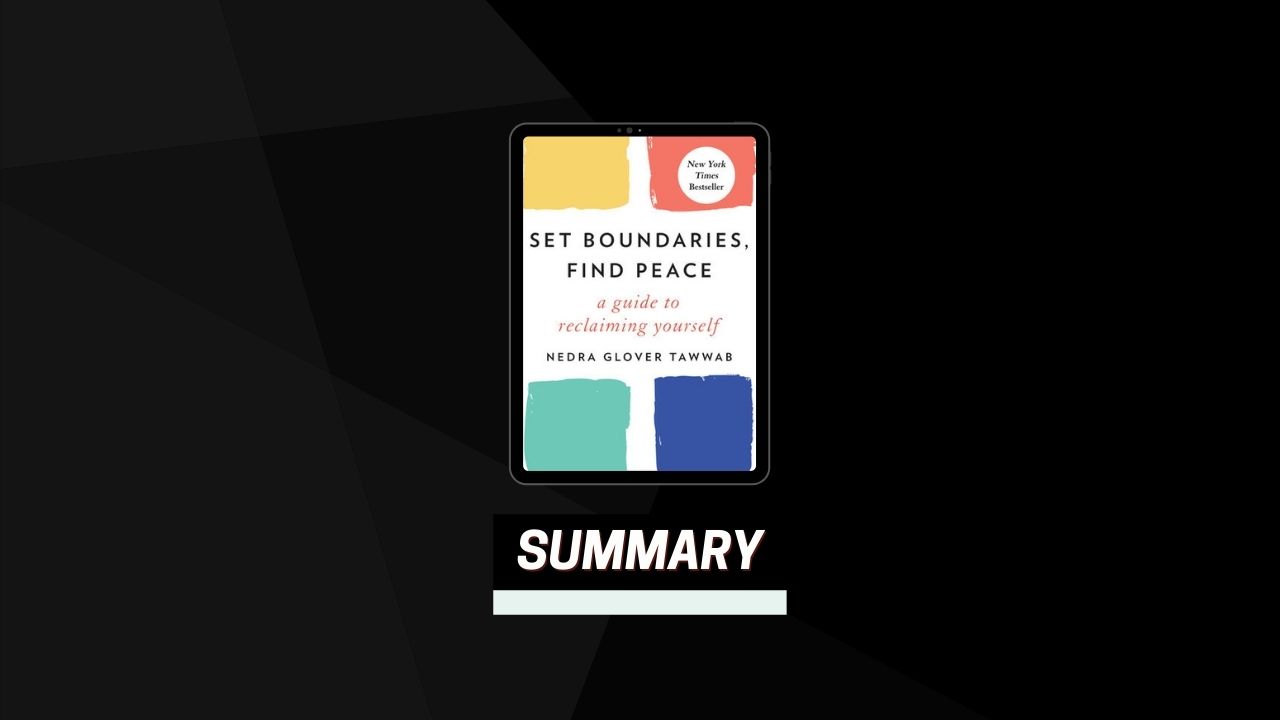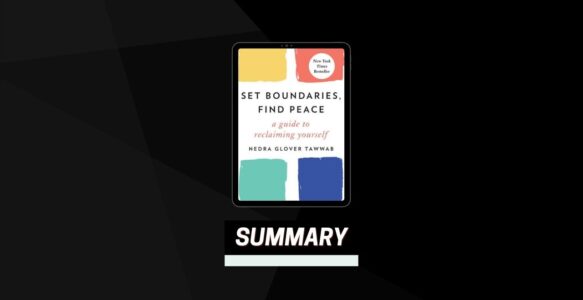Kindle | Hardcover | Audiobook
What the Heck Are Boundaries?
Boundaries are expectations and needs that help you feel safe and comfortable in your relationships. Expectations in relationships help you stay mentally and emotionally well. Learning when to say no and when to say yes is also an essential part of feeling comfortable when interacting with others.
The root of self-care is setting boundaries.
Self-care is more than taking a spa day, and it isn’t selfish. Saying no to helping is an act of self-care. Paying attention to your needs is self-care. And like putting on the oxygen mask, you’ll have more energy for others if you apply it to yourself first. If you think about it, the root of self-care is setting boundaries: it’s saying no to something in order to say yes to your own emotional, physical, and mental well-being.
Remember the signs that you need boundaries:
- You feel overwhelmed.
- You feel resentful toward people for asking for your help.
- You avoid phone calls and interactions with people who might ask for something.
- You make comments about helping people and getting nothing in return.
- You feel burned out.
- You frequently daydream about dropping everything and disappearing.
- You have no time for yourself.
Three Levels of Boundaries
There are actually three levels of boundaries. See if any of these sound familiar to you.
#1 Porous
Porous boundaries are weak or poorly expressed and are unintentionally harmful. They lead to feeling depleted, overextending yourself, depression, anxiety, and unhealthy relationship dynamics.
Porous boundaries look like:
- Oversharing
- Codependency
- Enmeshment (lacking emotional separation between you and another person)
- Inability to say no
- People-pleasing
- Dependency on feedback from others
- Paralyzing fear of being rejected
- Accepting mistreatment
Examples of porous boundary setting:
- Saying yes to things you don’t want to do
- Loaning money to people because you feel obligated or when you don’t have the funds to do so
#2 Rigid
At the other extreme, rigid boundaries involve building walls to keep others out as a way to keep yourself safe. But staying safe by locking yourself in is unhealthy and leads to a whole other set of problems. Whereas porous boundaries lead to unhealthy closeness (enmeshment), rigid ones are a self-protective mechanism meant to build distance.
Rigid boundaries look like:
- Never sharing
- Building walls
- Avoiding vulnerability
- Cutting people out
- Having high expectations of others
- Enforcing strict rules
Examples of rigid boundary setting:
- Saying no harshly as a way to discourage people from asking you in the future
- Having a rule that you never watch your sister’s kids
#3 Healthy
Healthy boundaries are possible when your past doesn’t show up in your present interactions. They require an awareness of your emotional, mental, and physical capacities, combined with clear communication.
Healthy boundaries look like:
- Being clear about your values
- Listening to your own opinion
- Sharing with others appropriately
- Having a healthy vulnerability with people who’ve earned your trust
- Being comfortable saying no
- Being comfortable hearing no without taking it personally
Examples of healthy boundary setting:
- Saying no without apologizing because it’s the healthiest choice for you at that moment
- Supporting people financially, when appropriate, and when you can do so without causing financial harm to yourself
Two Parts to Setting Boundaries
It’s true that setting boundaries isn’t easy. Paralyzing fear about how someone might respond can easily hold us back. You might play out awkward interactions in your mind and prepare yourself for the worst possible outcome. But trust me: short-term discomfort for a long-term healthy relationship is worth it every time!
Whenever you identify a boundary you’d like to set, remember that there are two steps to the process: communication and action.
Communication
Verbally communicating your needs is step one. People cannot accurately assume your boundaries based on your body language or unspoken expectations. When you explicitly state what you expect, there is little room for others to misinterpret what works for you. Assertive statements are the most effective way to do this.
Verbally communicating your boundaries sounds like this:
“When we have a disagreement, I’d like you to use a lower tone and take a break if you feel like you’re getting too heated in the argument. Also, I will mention when I’m becoming uncomfortable with your tone.”
“It’s important to me that you honor plans that we set up. If you need to change our plans, please send me a text a few hours before.”
Action
The process doesn’t end with the communication. You must uphold what you communicate through your behavior. Betting on the other person to read your mind is a recipe for an unhealthy relationship. Action is required. For instance, let’s say you’ve told your friend, “It’s important to me that you honor plans that we set up. If you need to change our plans, please send me a text a few hours before.” Because you’ve verbally communicated your boundary, when it’s violated, you need to reinforce it with action. In this case, you would let your friend know that you can’t accommodate the changed plans because they didn’t give you enough notice. You might say gently, “I want to hang out with you, but my schedule won’t allow for the adjustment. Let’s set up a time to get together next week.” It’s hard, I know. But honoring your boundaries through action is the only way most people will understand that you’re serious, which will help the people in your life become serious about your boundaries, too.
Boundaries In Action
Family
You may be the first in your family to set boundaries; remember that doing something different may elicit an unwelcome response.
Setting limits with family is particularly challenging. For years, your family has grown accustomed to you acting a certain way and playing a particular role. Change becomes necessary when you no longer want a situation to stay the way it has been. As difficult as it might seem, improving boundaries with your family is likely to create better relationships with them.
Romantic Relationships
It isn’t the responsibility of one person to fulfill every need you have. For instance, if your partner tends to offer you advice when you just want someone to listen, it may be more helpful to share with a friend. We can’t change people or convince them to be different from the core of who they are, and some needs may feel to your partner like an attempt to change them. In your relationships, it’s essential to consider if your request is reasonable. Requests are unreasonable when the other person can’t meet the need. For example, an unreasonable request could sound like “You can never bring up the past.” A reasonable request might sound like “If you bring up the past, I will verbalize that you’re crossing a boundary, and I will redirect the conversation.”
Friendships
When we maintain a friendship for ten years or more, we become accustomed to specific roles in the relationship. Therefore, shifting our boundaries seems like a betrayal of the relationship. But people change all the time. As we grow in friendships, other areas of our lives likely grow as well.
All life changes require a shift in boundaries, and some relationships don’t survive the changes. The dismissal is perhaps an indication of a crack in the foundation of the relationship, not the result of the new request. As we change, it’s simply natural for some friendships to fall away.
Work
There is no such thing as the perfect employee. You can have ethical boundaries and still be a good employee, coworker, or entrepreneur. In every workplace, there’s a person who has at least one boundary that everyone values about them. In this case, copy what you see.
If you happen to have a boss with poor limits, you don’t have to mimic their issues. Be very clear about yours, and if they’re challenged, speak up immediately.
It’s true that setting boundaries will sometimes upset others. Consider this: work is where people spend the majority of their time, and your time is valuable. Therefore, being comfortable in the space where you spend the most time is essential for your well-being.
Social Media & Technology
Technology is a part of our lives, and our dependence on it will grow. But you’re in charge of how you engage with it. Technology isn’t the problem. Social media isn’t the problem. Human engagement and consumption are more significant issues. You conquer technology when you find ways to use it to your benefit. Responsible usage requires implementing boundaries as to how you use it.
- Limit your access by not keeping multiple chargers in multiple spaces.
- Let your phone die. Use the time while it’s charging to recharge yourself.
- Use the screen-time feature on your phone to monitor your usage.
- Erase nonessential apps. Any app not used in the last month isn’t essential.
- Turn off notifications. Alerts trigger you to pick up your phone.
- Create rules about phone usage. Start big, and decrease weekly until you’re comfortable with the amount of time you spend on your phone.
- Unfriend people who aren’t real friends.
- Unfollow people who make you feel bad about yourself.
Now What?
Remember: there is no such thing as guilt-free boundary setting. If you want to minimize (not eliminate) guilt, change the way you think about the process. Stop thinking about boundaries as mean or wrong; start to believe that they’re a nonnegotiable part of healthy relationships, as well as a self-care and wellness practice.
Creating healthy boundaries is how you ensure that you’re happy and well in your relationships and in life. For them to stay implemented, be clear about them verbally and through your actions. Remember that when someone doesn’t agree with or understand your boundaries, they may push back, question, test your limits, ignore, or ghost you. No matter what, don’t stop setting them. Persevere with the awareness that your boundaries are not for people to like. They’re for you to remain healthy in your relationships. They’re a way for you to set ground rules for yourself and others. And they’re useful in all areas of life: technology, work, your relationship with yourself, and your relationships with others. So it’s okay to have boundaries and to communicate them assertively.
Only with boundaries can you peacefully coexist with others.



